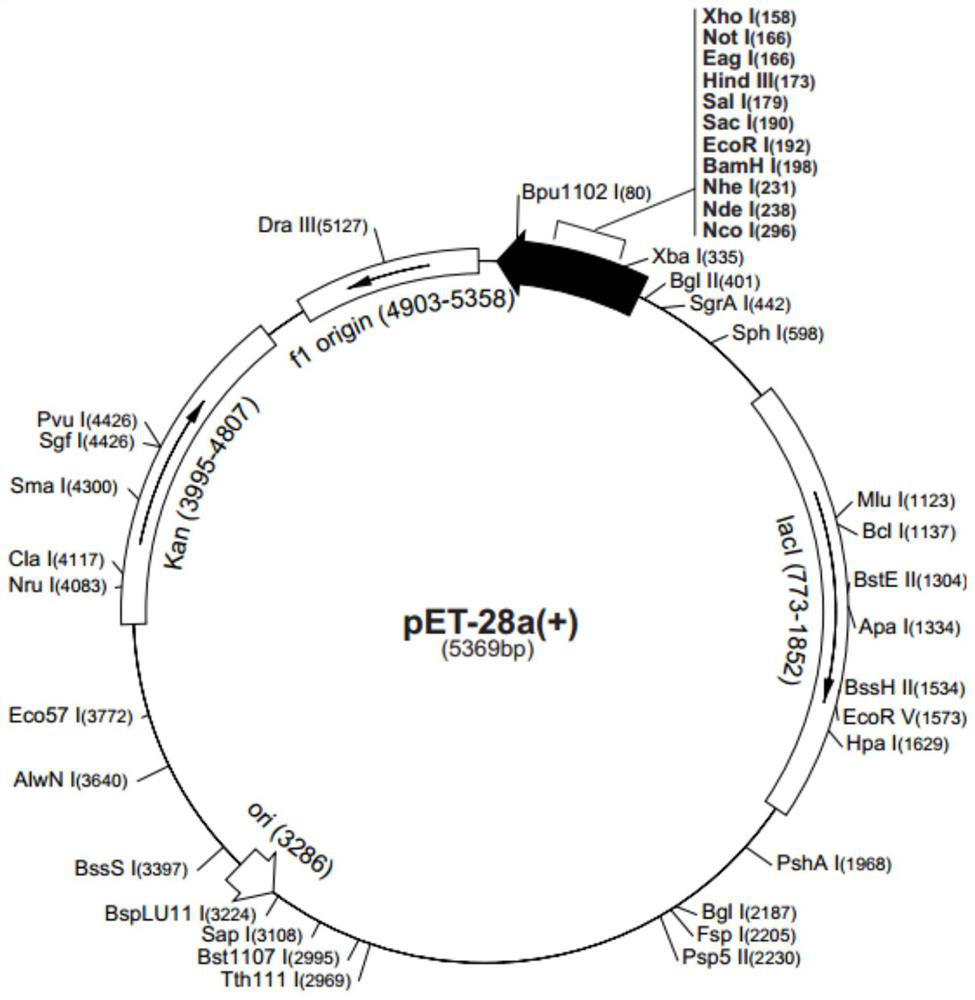Application of recombinant vibrio parahaemolyticus flagellin in improvement of fish immunity
A technology of Vibrio hemolyticus and flagellin is applied in the field of genetic engineering to achieve the effects of improving immunity, improving fish immunity and good application value
- Summary
- Abstract
- Description
- Claims
- Application Information
AI Technical Summary
Problems solved by technology
Method used
Image
Examples
Embodiment 1
[0035]Cloning of embodiment 1 Vibrio parahaemolyticus flagellin FlaA, FlaB, FlaC, FlaD, FlaE, FlaF genes
[0036] 1. Experimental method
[0037] (1) Extraction of Vibrio parahaemolyticus DNA
[0038] We used the Bacterial Genomic DNA Extraction Kit (Tiangen, China) to extract the total DNA of Vibrio parahaemolyticus, and the operation steps were as follows:
[0039] ① Take 3 mL of Vibrio parahaemolyticus, centrifuge at room temperature at 10,000 rpm for 1 min, suck off the supernatant as much as possible, add 200 μL buffer GA to the cells, and shake until the cells are completely suspended.
[0040] ②Add 20 μL proteinase K to the tube and mix well.
[0041] ③ Add 220 μL buffer GB, shake for 15 seconds, place at 70°C for 10 minutes until the solution becomes clear, and briefly centrifuge to remove water droplets on the inner wall of the tube cap.
[0042] ④ Add 220 μL of absolute ethanol, vortex and mix well for 15 seconds, when a flocculent precipitate appears, centrifuge ...
Embodiment 2
[0057] Embodiment 2 Construction of recombinant Vibrio parahaemolyticus flagellin FlaA, FlaB, FlaC, FlaD, FlaE, FlaF prokaryotic expression vector
[0058] 1. Experimental method
[0059] (1) In order to introduce the His fusion tag, first clone the ORF fragments encoding the Vibrio parahaemolyticus flagellin FlaA, FlaB, FlaC, FlaD, FlaE, and FlaF into the pET28a(+) vector (the map of the pET28a vector is as follows figure 2 Shown), the prokaryotic expression vectors pET28a-flaA, pET28a-flaB, pET28a-flaC, pET28a-flaD, pET28a-flaE, pET28a-flaF of His fusion tag were constructed. The primers and their sequences used to construct the above prokaryotic expression vectors are shown in Table 2.
[0060] (2) The complete ORF coding sequence with the fusion tag His was amplified with the primers shown in Table 2, and cloned into pET28a(+) vector by CloneExpressII One Step Cloning Kit (Novazyme, China).
[0061] Table 2
[0062]
[0063] 2. Experimental results
[0064] The pro...
Embodiment 3
[0065] Prokaryotic expression of embodiment 3 recombinant Vibrio parahaemolyticus flagellin FlaA, FlaB, FlaC, FlaD, FlaE, FlaF
[0066] 1. Experimental method
[0067] (1) The correct prokaryotic expression vector pET28a-flaA obtained in Example 2, pET28a-flaB, pET28a-flaC, pET28a-flaD, pET28a-flaE, pET28a-flaF are transformed into Escherichia coli BL21 (DE3), through LB Kan﹢ Plates were incubated overnight at 37°C.
[0068] (2) Pick a single colony in 5mL LB Kan﹢ In liquid medium, activate overnight at 37°C, 200rpm.
[0069] (3) Inoculate 50 mL of fresh LB at a ratio of 1:100 Kan﹢ In liquid medium, culture at 37° C. and 200 rpm for 2.5 hours so that OD600=0.6-0.7.
[0070] (4) Add IPTG to a final concentration of 0.5 mM, induce culture at 25° C. and 200 rpm for 4 h.
[0071] (5) Take 500 μL of bacterial liquid, collect the bacterial cells by centrifugation at 4°C, 10,000 rpm, resuspend the bacterial cells with 40 μL of PBS, add 5×SDS loading buffer, treat at 100°C for 1...
PUM
 Login to View More
Login to View More Abstract
Description
Claims
Application Information
 Login to View More
Login to View More - R&D
- Intellectual Property
- Life Sciences
- Materials
- Tech Scout
- Unparalleled Data Quality
- Higher Quality Content
- 60% Fewer Hallucinations
Browse by: Latest US Patents, China's latest patents, Technical Efficacy Thesaurus, Application Domain, Technology Topic, Popular Technical Reports.
© 2025 PatSnap. All rights reserved.Legal|Privacy policy|Modern Slavery Act Transparency Statement|Sitemap|About US| Contact US: help@patsnap.com



